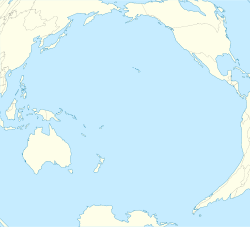Gascoyne Seamount
| Gascoyne Seamount | |
|---|---|
| Location | |
| Location | 500 km (310 mi) east of Bermagui, New South Wales, Australia |
| Group | Tasmantid Seamount Chain |
| Coordinates | 36°39′32.2″S 156°12′20.2″E / 36.658944°S 156.205611°E |
| Geology | |
| Type | Guyot |
Gascoyne Seamount, also called Gascoyne Guyot or Gascoyne Tablemount, is a guyot in the Tasman Sea of the South Pacific Ocean.
Geography
Located 500 km (310 mi) east of the Australian coastal town of Bermagui, Gascoyne Seamount is the southernmost and youngest significant seamount of the Tasmantid Seamount Chain. This is an underwater mountain range extending some 1,300 km (810 mi) to the north.[1] The Tasmantid Seamount Chain has resulted from the Indo-Australian Plate moving northward over a stationary hotspot.[2]
Geology

The seamount is about 7 million years old.[3] It incorporates a tropical to subtropical, very shallow water calcareous algal/encrusting foraminiferid biota, suggesting deposition in water 15 to 20 m (49 to 66 ft) deep. Age diagnostic forms have not been recovered.[4]
Gascoyne Seamount is named after HMAS Gascoyne, one of two ships in the Royal Australian Navy assigned to Australian programs in the International Indian Ocean Expedition, which took place from 1960 to 1965.[5]
References
- ^ Johnson, David (2009). The Geology of Australia. Cambridge University Press. pp. 201, 202. ISBN 978-0-521-767415.
- ^ W. J. Morgan and J. P. Morgan. Plate velocities in hotspot reference frame: electronic supplement.
- ^ "Magma production along the Lord Howe Seamount Chain, northern Zealandia". Cambridge University Press. 2019. Retrieved 2020-05-12.
- ^ Quilty, Patrick G. (1993). "Tasmantid and Lord Howe seamounts: biostratigraphy and palaeoceanographic significance". Alcheringa: An Australasian Journal of Palaeontology. 17. Taylor & Francis: 27–53. Bibcode:1993Alch...17...27Q. doi:10.1080/03115519308619487. Retrieved 2020-05-12.
- ^ "Marine Gazetteer Placedetails". Retrieved 2020-05-11.

